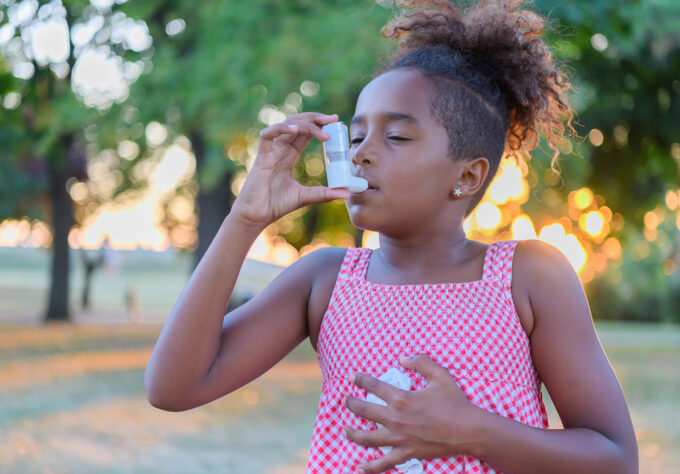For most parents and kids, spring means sunny warm weather, outdoor sports and more outside playtime. For many others, spring also means more asthma flare-ups – more time outside means more exposure to asthma triggers, and more sports means more exercise-induced asthma.
Although childhood asthma is common, many people really don’t know much about it. So we thought we’d answer some common questions about what asthma is and how it’s treated.
1. What is asthma, exactly?
Asthma is a chronic disease that affects the airways in the lungs, called “breathing tubes” (or “bronchial tubes”). It’s actually the most common long-term childhood disease – the No. 1 reason kids chronically miss school. And flare-ups are the most common cause of pediatric emergency department visits due to a chronic illness.
Those affected by asthma typically have swollen airways (which means that they swell and produce lots of thick mucus) most of the time. Their airways are overly sensitive (or “hyperreactive”) to certain asthma triggers like cigarette smoke, allergens, irritants, exercise and viral infections that can cause a flare-up (or “asthma attack”). So, during an asthma flare-up, these tubes swell up even more, making it difficult to breathe.
2. What’s an asthma flare-up?
Basically, the breathing tubes constrict – like a straw being squeezed – which triggers wheezing, coughing and tightness in the chest. Some kids experience flare-ups while exercising and others when they come in contact with smoke, chalk dust or other airborne pollutants. Asthma can also be worse in certain types of weather, like cold air or during an allergy season. After these flare-ups, the bronchial tubes almost always return to normal, but sometimes it can take a few days.
3. What are some common allergens and irritants? And what’s the difference?
Asthma flare-ups are caused by triggers – which can include substances, weather conditions or activities – that irritate and inflame the airways in the lungs. Triggers can change from season to season and as kids get older.
One of the most common asthma triggers is allergens, which can include mold, dust mites, cockroaches, pollen, animal dander and feathers. If kids inhale something they’re allergic to, this can inflame the airways and cause a flare-up. If you can help them to avoid the allergens that affect their asthma or minimize their presence in your home, this will likely lead to fewer asthma flare-ups. To do this, some homeowners could consider getting an air conditioning unit installed in their homes. Air Handlers are responsible for moving air around the house, so it’s important to find one of those. That will improve air quality and, hopefully, make it easier for your child to breathe comfortably. A good rule of thumb is to have your air conditioner tuned up every few months so that dust particles don’t affect your space. In case of a malfunction, you can have the malfunctioning part repaired so that your house remains dust-free. That said, if you want AC service in Denton and clean air for your home, you might consider visiting jakservices.com/denton-air-conditioning-repair-service/ or similar websites.
4. Are there different levels of severity of asthma, or is it the same for every child?
Asthma affects different children in different ways. Some are only affected after exercising or by specific irritants such as perfume, whereas others are affected by multiple allergens and irritants. Some kids have mild, manageable symptoms, and others require more serious attention.Typically, a child’s asthma will fall into one of the following categories:
- Mild intermittent asthma: Episodes of wheezing, coughing or shortness of breath occur no more than twice a week. Symptoms are rare between flare-ups, and nighttime symptoms are typically mild.
- Mild persistent asthma: Episodes occur at least twice a week, but less than once a day. Symptoms also typically occur at night at least twice a month, and may affect physical activity.
- Moderate persistent asthma: Episodes occur more than twice a week (lasting sometimes for a few days). Daily symptoms are often affected by exercise, and nighttime symptoms are typically present more than once a week.
- Severe persistent asthma: Episodes occur frequently, and symptoms are continuous during the day and night. Often, only limited physical activity can be handled.
5. What’s exercise-induced asthma?
Some kids experience asthma symptoms after physical activity, so they’re said to have “exercise-induced asthma.” Some will have other asthma triggers in addition to exercise, whereas others will only experience symptoms after exercise. Your child’s primary care doctor may recommend that your child take preventative medicine before exercising, or carry quick-relief medications to gym class, practices, recess or wherever else your child may be active.
According to the American Academy of Allergy, Asthma & Immunology, more than 20 percent of professional athletes live with asthma. With the proper treatment and precautions, there’s no reason your child with asthma can’t still be physically active.
6. How did my child get asthma?
Honestly, we don’t really know. What we do know is that asthma typically runs in families and can be helped or hurt by environmental factors, so experts believe it’s a combination of the two.
7. I know people with asthma use inhalers, but what does the inhaler do?
Metered dose inhalers (MDI) are portable, handheld devices that are like mini-aerosol cans. Sticking with the straw analogy, they help to “unsqueeze” the straw when the breathing tubes constrict during an asthma flare-up. The inhaler has a small plastic tube which releases the medicine in a mist that relaxes the airways so they’re not constricted. It is important to use a spacer when using an MDI. Without a spacer, much of the medication is swallowed and does not reach the lungs where it is needed. A spacer is a plastic tube that holds the mist in between the MDI and the child’s mouth.
Some inhalers are “dry powder inhalers,” which don’t spray out the medicine but, instead, deliver it in powder form. Kids who use this kind of inhaler must do more of the work, inhaling the powdered medicine quickly and forcefully (which is why dry powder inhalers often aren’t ideal for very young kids).
8. Are inhalers the only treatment for asthma flare-ups?
No – in fact, asthma affects everyone in different ways, so doctors develop individualized plans for each asthma patient. The two main categories of asthma medications are:
- quick-relief medicines (also called “rescue” or “fast-acting” medicines), which work right away to relieve asthma symptoms
- long-term control medicines (also called “controller” or “maintenance” medicines), which work over a period of time to help prevent asthma symptoms from happening in the first place
Inhalers can be used to deliver quick-relief and/or long-term control medicines. So can nebulizers, which are electric- or battery-powered machines that turn liquid asthma medicine into a fine mist that’s inhaled into the lungs. Nebulizers require kids to sit still for longer to get the medicine, but they don’t need to do anything special to get it – just sit there and breathe.
Some kids with asthma rely only on quick-relief medications; others use a quick-relief medicine with a long-term control medicine to help keep their asthma in check. To determine what type of treatment kids need, doctors use a spirometry test (which measures how much air your child’s lungs can push out) or a challenge test (which can confirm what substance triggers the asthma). Based on this, doctors can come up with a plan.
Some kids are able to avoid their triggers, and others are not. Some children – like those affected by exercise-induced asthma – can take their medicine to help prevent an attack.
9. What’s a peak flow meter?
To measure lung function and find out whether your child’s airways are inflamed or obstructed, your doctor might recommend using an inexpensive, portable device called a “peak flow meter,” which measures the flow of air as it’s expelled from the lungs. This information can help you manage your child’s asthma and avoid major flare-ups.
To use a peak flow meter, your child will blow into it (as if blowing up a balloon). To indicate how much air was exhaled, a marker will slide up a scale on the meter as your child blows out. The “peak flow” is the number where the marker stops on the scale.
Using a peak flow meter can give you and your doctor important information about:
- the severity of your child’s asthma
- how well your child is responding to asthma medicines during a flare-up
- whether your child’s asthma is getting worse
10. What’s the difference between an “asthma action plan” and an “asthma diary?” And do kids with asthma need to use both?
An “asthma action plan” is a set of individualized directions that a doctor will design to help someone cope with asthma at home as either preventative methods or as treatments. This plan can include:
- a list of asthma triggers
- how to limit exposure to these triggers
- a list of symptoms and what to do if one should appear
- the names and doses of asthma medicines and when they should be taken
An “asthma diary,” on the other hand, is a journal for you or your child to monitor and record asthma symptoms, peak flows and the medicine taken each day. Keeping an asthma diary can help your child’s primary care doctor form an asthma action plan or determine if the one you have is working.
With the right treatment and management, asthma doesn’t have to impact your child’s quality of life.



